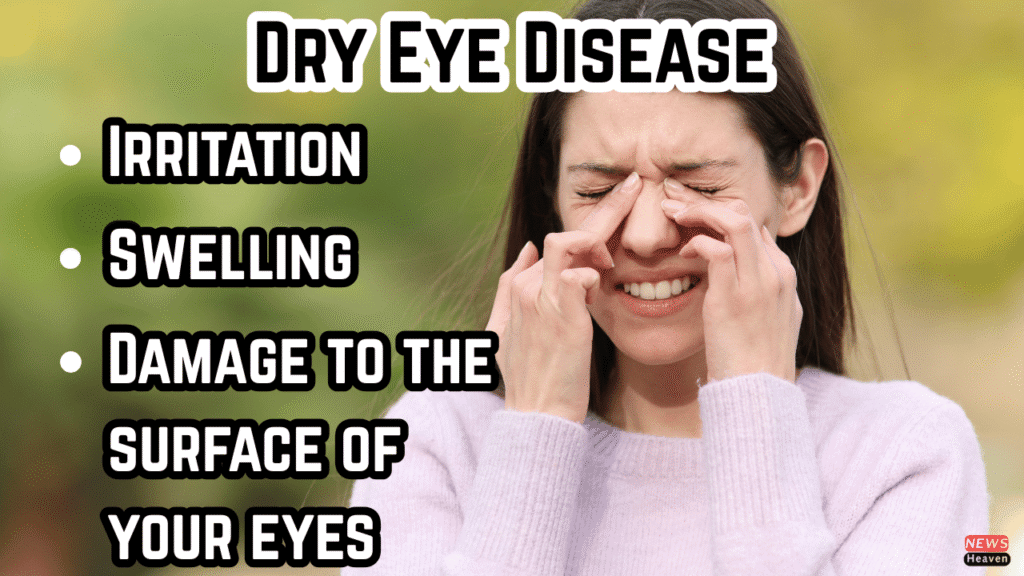Learn all about Dry Eye Disease (DED) this Dry Eye Awareness Month 2025. Discover the causes, symptoms, and effective management strategies to relieve discomfort and maintain healthy eyes.

Dry Eye Awareness Month 2025: Learn about the causes, symptoms, and ways to deal with dry eye disease.
It’s vital to talk about Dry Eye Disease (DED) during Dry Eye Awareness Month 2025 because it’s one of the most common yet least diagnosed disorders that affects millions of individuals throughout the world. Lifestyle issues, including spending too much time in front of screens, pollution, and becoming older, are all important contributors to the increase of DED. To keep your eyes healthy and comfortable, it’s important to know what causes DED, how to recognize its symptoms, and how to treat it.
What Is Dry Eye Disease (DED)?
When your eyes don’t make enough tears or when your tears dry up too soon, it can cause irritation, swelling, and damage to the surface of your eyes. This is what happens when you have dry eye disease. If you don’t cure this illness, it can make your daily life much harder and perhaps cause eyesight problems.
There are two primary types of DED:
- Lack of Aqueous Tear
This type develops when the lacrimal glands don’t make enough tears. It is often associated with autoimmune diseases like Sjögren’s syndrome. - Dry Eye That Evaporates
This is the more common form, and it happens when the tear film dries up too soon. This is usually because the meibomian glands aren’t working right, which makes the lipid layer of the tears thinner.
Signs and Symptoms of Dry Eye Disease
The symptoms of DED can be modest to severe, and they can make you uncomfortable and lower your quality of life. Some indications that are common are
- A gritty or sandy feeling in the eyes, which is often painful
- Feeling like your skin is burning or stinging, especially after being outside for a long time or using a computer.
- The eyes are red, which makes them look angry or inflamed.
- Vision that is blurry and can change during the day
- Too much tearing, which happens as the body tries to make up for dry eyes
- Being sensitive to light, especially in bright places
- Tired eyes, especially after reading, working on a computer, or wearing contacts
Causes and Risk Factors for Dry Eye Disease
There are a number of things that might cause DED. These are
- Strain on the Eyes from Digital Devices
The way we live today, with more time spent on computers, cellphones, and tablets, slows down the natural blink rate, which makes tears dry up faster than they can be made. - Factors in the environment
Dry air, air conditioning, and pollution can make dry eye symptoms worse if you are around them for a long time. Tears also evaporate when there is wind and smoke. - Age
As we become older, our bodies naturally make fewer tears, which makes older people more likely to get dry eyes. - Changes in hormones
Changes in hormones, especially in women who are pregnant, going through menopause, or using birth control, might change how many tears are made. - Health Problems
Certain medications, like antihistamines and blood pressure drugs, and autoimmune illnesses like Sjögren’s syndrome might make it harder for your body to make tears.
How to Handle and Cure Dry Eye Disease
To treat dry eye illness, you may need to make changes to your lifestyle, get medical care, and sometimes use prescription drugs. Here are some good techniques to ease the symptoms and stop the problem from getting worse:
- Artificial Tears
You can get over-the-counter lubricating eye drops to help with moderate symptoms. These drops assist in keeping your eyes moist and replenish moisture that has been lost. - Warm Compresses
Putting a warm compress over your eyes will help open up clogged meibomian glands and make the tear film better, which can help with symptoms. - Taking care of your eyelids
Cleaning your eyelids often might help get rid of dirt and oils that block the glands and make your eyes dry. - Fatty Acids Omega-3
Adding omega-3 fatty acids to your diet, either through food or supplements, may help you make more tears. - Medications with a prescription
In very bad cases, doctors may give you anti-inflammatory drugs such as cyclosporine A (Restasis) or lifitegrast (Xiidra) to help with swelling and make more tears. - Changes to the environment
Avoiding direct air from fans or air conditioners and using a humidifier to add moisture to dry indoor air might help keep your eyes pleasant.
How to Avoid Getting Dry Eye Disease
When it comes to taking care of dry eyes, prevention is the most important thing. Here are some things you can do to lower your risk of getting the condition:
- To prevent digital eye strain, use the 20-20-20 Rule: every 20 minutes, look at anything 20 feet away for 20 seconds.
- Drink a lot of water throughout the day to keep your body, particularly your eyes, hydrated.
- Limit Screen Time: Give your eyes a vacation from screens every so often so they can relax and blink more often.
- Put on protective eyewear: Sunglasses or goggles that wrap over your eyes can help keep them safe from wind and dry air.
- Keep the air moist: If you live in a dry place, using a humidifier might help keep your eyes from getting too dry.
When to Go to the Eye Doctor
It’s crucial to see an eye care specialist if you have symptoms that don’t go away, like eye pain, vision issues, or more irritation. A full eye exam can find out what’s causing your dry eyes and help you come up with a treatment plan that works for you to improve your symptoms and your life better.
In conclusion, Take Action This Dry Eye Awareness Month
It’s important to increase awareness about dry eyes and learn how to properly manage them as we celebrate Dry Eye Awareness Month. You may avoid pain and keep your eyes healthy by learning about the causes and symptoms of dry eye disease, making essential changes to your lifestyle, and getting the right treatment.
Keep in mind that your eyes are crucial to your health. If you do the right things today, they will stay healthy for a long time.
Also read: World Lung Cancer Day 2025: Breaking Barriers for Early Detection and Equal Care

Pingback: 7 Surprising Causes of Sore Throat You Shouldn’t Ignore (And How to Address Them)
Pingback: Kids Health Protection in Monsoon: 10 Tips Every Parent Should Know